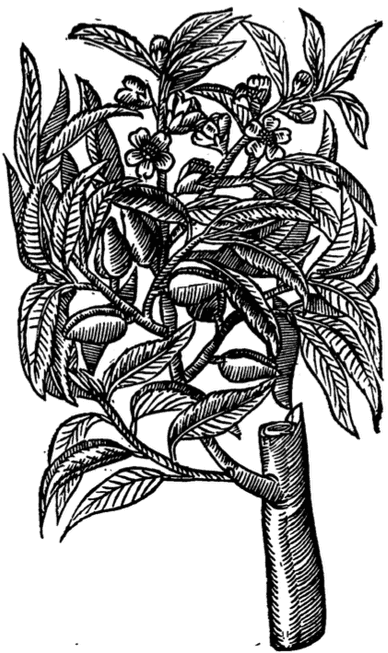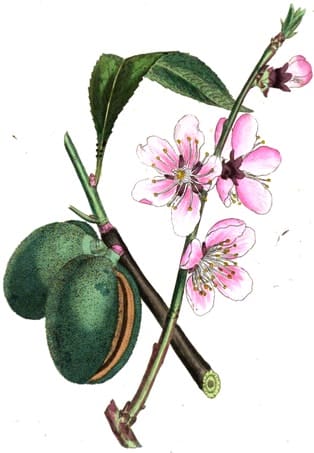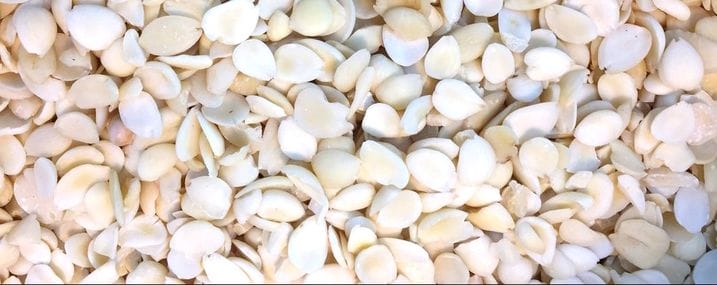Prunus amygdala amara, Bitter AlmondMaghz e Badam Talkh (Unani)Ku Xing Ren (TCM, usd for Bitter Apricot and Almond kernel) |

|

|

|

|
|
Parkinson, Theatrum Botanicum, 1640 |
Medical Botany, Woodville, Hooker, Vol. 3, 1832 |
 Almond (Xing Ren) (Adam, 2017)
Almond (Xing Ren) (Adam, 2017)Botanical name:
Prunus amygdalus amara (formerly Amygdalus communis)
Apricot kernels from P. armenica are used similarly in TCM.
Parts used:
Kernels
Temperature & Taste:
Warm, dry. Sweet, Bitter.
Classifications:
2A APERIENT MEDICINES. 2F. PURIFYING. 2G. CLEANSING. 2Q. ANODYNE
3E. DIURETIC. 3G. EMMENAGOGUE.
4e. STOMACHIC. 4f. SPLENETIC. 4g. HEPATIC
TCM:
Q. Stop Cough and Wheezing
Uses:
1. Clears Phlegm, Stops Cough and Wheezing:
-acute and chronic Cough
-Asthma, shortness of Breath, Wheezing
-spitting of Blood. (Gum is used similarly: Dioscorides)
-stronger for Cough and Wheezing, but weaker to strengthen than Sweet Almond
2. Moves the Blood, Opens Obstructions, Clears Stasis:
-it cuts and opens thick, chronic, and deep-seated humors
-chronic obstructions, coagulated blood, Fibroid tumors.
-bruised blood
-clears skin spots and pityriasis versicolor (Unani)
-Headache related to Obstruction; Salmon also said they ‘cure the Headache by chewing’.
-promotes Menstruation.
3. Clears Heat from the Liver, Opens Obstructions:
-pains of the sides
-very good for all old obstructions of the Liver and Spleen.
-‘prevents drunkenness if 5 or 7 are taken beforehand’ (Dioscorides)
-‘They delay drunkenness’. (Tacuinum Sanitatus)
4. Promotes Urine:
-difficult Urination, Strangury, painful urination and Stones.
–Avicenna regarded the highly in obstruction of the Kidneys.
–Dioscorides said the Gum of the Tree was good for stones.
5. Opens the Bowels:
-mildly laxative.
6. Externally:
-applied with Vinegar or Oil of Roses to the temples for Headache. (Dioscorides)
-the Oil dropped into the ears is very good for ear problems including Earache and Tinnitus; ‘more agreeable to the ears than any other Oil’.
-they have been applied externally to promote Menstruation.
-externally, the expressed oils of both this and the Sweet may be used for hardness and pains of the Nerves.
-with Honey, they are applied to the bitings of Mad Dogs.
-applied to Herpes. (Avicenna)
-as a scrub to remove Freckles
-‘cleanses the skin from scurf, morphew, spots and blemishes, if it be mixed with Oil of Scorpions, and so used’. (Salmon)
Dose:
Powder: 500mg–2 grams (up to 3 grams)
Decoction: 3–9 grams
Correctives:
1. Sugar; Sugar Candy;
2. Sweet Almonds; Sweet Almond oil (Unani)
Substitutes:
Cherry kernels
Comment:
1. Sweet Almonds are strengthening, nourishing and fattening, increasing Qi and Yin; Bitter Almonds and opening, cleansing and promote Digestion. They drain, open obstructions and cleanse Phlegm and remove Blood stagnation.
2. Bitter Almonds were much used in ancient formulas. They cut, cleanse, penetrate and resolve thick, compacted and stubborn Humors, and old cases of Blood coagulation.
3. Almond and Apricot kernels are largely synonymous. The Chinese name Xing Ren is used for either Almond or Apricot, both having sweet and bitter varieties.
Main Combinations:
Almond & Licorice
Peach kernel / Bitter Almond kernel & Saffron / Safflower
1. Cough:
i. Cold Cough, Bitter Almond with Fennel seed and Sugar (as in Powder to Warm the Lungs of Mesue)
ii. from Heat, Bitter Almond with Licorice juice, Tragacanth, Gum Arabic (as in Pills for Hot Cough)
iii. Cold and Moist Cough, Sweet and Bitter Almond, Myrrh, Saffron, Pine nut, Aniseed, White Poppy seed, Licorice (as in Pills for Cold and Moist Cough of Paulus)
iv. cold and thick Phlegm and deficiency, Bitter Almond, Pine nut, Fig, Raisin, Pennyroyal, Licorice, Hyssop, Tragacanth, Ginger, Storax (as in Electuary of Orris Root of Nicholas)
v. Chronic Cough, Bitter Almond with Costus, Saffron, Aloe, Storax, Myrrh, Gentian, Wormwood, Aniseed, Fenugreek, Honey (as in Antidote for the Liver and Chronic Cough)
vi. Cough, and to purify the Lungs: Bitter Almond, Sweet Almond, Starch, Sugar (20 drams each), Amomum, Cinnamon (3 drams each). Add sufficient Honey to form an Electuary. (Syrian “Book of Medicine“, trans. by Wallis Budge, 1913)
2. Asthma:
i. Bitter Almond with Licorice, Hyssop, Maidenhair, Orris, Radish seed (as in Electuary for Asthma)
ii. Bitter Almond with Fennel root, Aniseed, Licorice, Sweet Almond, Hyssop, Fig (as in Decoction for Asthma from Crass Humors)
3. To cleanse the Lungs, Pine nuts, Bitter Almond, Licorice juice, form an Electuary with Honey.
4. Jaundice, Liver obstruction:
i. Bitter Almond, Celery seed, Wormwood, Aniseed (as in Bitter Troches of Nicholas)
ii. Bitter Almond with Aniseed, Wormwood, Indian Spikenard (as in Troches for the Liver and Jaundice of Nicholas)
iii. Bitter Almond with Gentian, Greater Cardamon, Wormwood, Costus, Agrimony (as in Decoction for the Liver)
iv. Bitter Almond with Celery seed, Wormwood, Aniseed, Asarum (as in Troches of Wormwood Lesser of Mesue)
v. Bitter Almond with Wormwood, Fennel seed, Aniseed, Rose, Asarum, Indian Spikenard, Celery seed, Rhubarb, Agrimony (as in Troches of Wormwood Greater)
5. Bruising, Bitter Almond with Red Earth and Dragons Blood (as in Powder for Bruising of Wirtzung)
6. Edema, Urinary retention:
i. Bitter Almond with Rhubarb, Agrimony, Madder, Celery seed (as in Powder for Edema)
ii, Bitter Almond with Madder, Juniper berry, Fennel seed, Indian Spikenard (as in Pills for Retention of Urine)
iii. Bitter Almond with Celery seed, Madder, Parsley seed, Asarum, Fennel seed, Indian Spikenard, Melon seed (as in Pills to Promote Urine)
Major Formulas:
Decoction of Maidenhair (Humain)
Decoction for Asthma from Crass Humors (Hamech)
Decoction for the Liver (Nicholas)
Powder of Gum Lacca Greater (Dialacca Majores) (Mesue)
Powder of Gum Lacca Lesser of Rhasis (Dialacca Minor) (Rhasis)
Powder to Warm the Lungs (Mesue)
Powder for Bruising (Wirtzung)
Powder for Edema (Wirtzung)
Troches of Gum Lacca (Trochisci de Lacca) (Mesue)
Troches of Gum Lacca (Trochisci de Lacca) (Unani)
Troches of Wormwood Lesser (Mesue)
Troches of Wormwood Greater
Troches of Rhubarb (Mesue)
Troches of Winter Cherry (Trochisci Alkekengi) (Mesue)
Electuary of Pine Nuts (Looch de Pino) (Mesue)
Electuary of Orris Root (Diaireos Salomonis) (Nicholas)
Electuary Preventing Drunkenness (Unani)
Pills for Hot Cough (Zacharia)
Pills to Promote Urine (Unani)
Cautions:
1. Bitter Almond kernels are toxic in overdose due to amygdalin which hydrolyzes to release hydrocyanic acid and inhibits the respiratory center
2. Bitter Almonds can potentiate the respiratory depressant effects of Morphine.
Toxicity:
7–10 Bitter Almonds can be fatal for children, 50–60 to adults.
Main Preparations used:
Bitter Almond Oil
-
Extra Info
-
History
|
‘Almonds are mentioned in the Book of Genesis as having been carried into Egypt from Palestine as a present by the sons of Israel; they are frequently noticed by Theophrastus; Dioscorides describes the use of the root, seeds and gum of the bitter almond tree as medicinal agents. Pliny also was acquainted with almonds and the almond tree (amygdala). He as well as Celsus and Columella, speak of ‘nux amara,’ ‘the bitter almond’; almonds were also called Avellanae Graecae and Nuces Graecae by Latin writers. Much interesting information having regard to the ancient history of Almonds in Europe may be found in the Pharmacographia. In India the Almond, though probably indigenous to Cashmere and the Himalayas, does not appear to have attracted the same attention as in Europe. In some Sanskrit works it is mentioned under the name of Badama, the same name which it bears in Persia, where the the tree is very common and the fruit much used. When the Mahometans settled in India, Almonds were probably for the first time introduced into the southern and central parts of the country as an article of commerce from Persia. Arabic and Persian writers on Materia Medica discuss their properties at consider able length. The uses to which they put sweet Almonds are essentially the same as with us. The author of the Makhzan-el-Adwiya mentions two kinds of sweet Almond, the thick-shelled and the thin |
(or Kaghazi). He describes the method of extracting the perfumes of flowers by means of Almonds placed in contact with them, and says that the oil being afterwards expressed retains the perfume of the flower. He also notices the use of the burnt shells as tooth powder, and of the unripe fruit (Chugala) as an astringent application to the gums and mouth. Bitter Almonds are described by Mahometan writers as attenuant and detergent; they are recommended both internally and externally for a variety of purposes. As a plaster made with vinegar they are used to relieve neuralgic pains; as a collyrium, to strengthen the sight ;in emulsion with starch and peppermint, to allay cough. They are also considered to be lithontriptic and diuretic, and of use for removing obstructions of the liver and spleen; applied to the head they kill lice; as a suppository they relieve pain in difficult menstruation; as a poultice they are a valuable application to irritable sores and skin eruptions. The root of the tree is described as discutient and alterative; it is used both internally and externally. The gum, with that of the plum tree, which is known in Bombay as “Badami gond,” is one kind of Hog gum or Gum Bassora of European commerce, and is used in the East as a cheap substitute for more soluble gums. The oil of Almonds is not an article of commerce in Bombay.’ (Vegetable Materia Medica of Western India, Dymock, 1885) |
